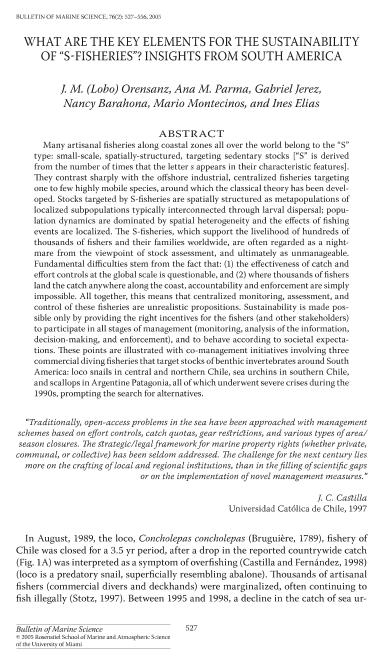Artículo
What are the key elements for the sustainability of "S fisheries"? Insights from South America
Orensanz, Jose Maria ; Parma, Ana María
; Parma, Ana María ; Jerez, Gabriel; Barahona, Nancy; Montecinos, Mario; Elias, Ines
; Jerez, Gabriel; Barahona, Nancy; Montecinos, Mario; Elias, Ines
 ; Parma, Ana María
; Parma, Ana María ; Jerez, Gabriel; Barahona, Nancy; Montecinos, Mario; Elias, Ines
; Jerez, Gabriel; Barahona, Nancy; Montecinos, Mario; Elias, Ines
Fecha de publicación:
12/2005
Editorial:
Rosenstiel School of Marine and Atmospheric Science
Revista:
Bulletin of Marine Science
ISSN:
0007-4977
Idioma:
Inglés
Tipo de recurso:
Artículo publicado
Clasificación temática:
Resumen
Many artisanal fisheries along coastal zones all over the world belong to the “S” type: small-scale, spatially-structured, targeting sedentary stocks [“S” is derived from the number of times that the letter s appears in their characteristic features]. They contrast sharply with the offshore industrial, centralized fisheries targeting one to few highly mobile species, around which the classical theory has been developed. Stocks targeted by S-fisheries are spatially structured as metapopulations of localized subpopulations typically interconnected through larval dispersal; population dynamics are dominated by spatial heterogeneity and the effects of fishing events are localized. The S-fisheries, which support the livelihood of hundreds of thousands of fishers and their families worldwide, are often regarded as a nightmare from the viewpoint of stock assessment, and ultimately as unmanageable. Fundamental difficulties stem from the fact that: (1) the effectiveness of catch and effort controls at the global scale is questionable, and (2) where thousands of fishers land the catch anywhere along the coast, accountability and enforcement are simply impossible. All together, this means that centralized monitoring, assessment, and control of these fisheries are unrealistic propositions. Sustainability is made possible only by providing the right incentives for the fishers (and other stakeholders) to participate in all stages of management (monitoring, analysis of the information, decision-making, and enforcement), and to behave according to societal expectations. These points are illustrated with co-management initiatives involving three commercial diving fisheries that target stocks of benthic invertebrates around South America: loco snails in central and northern Chile, sea urchins in southern Chile, and scallops in Argentine Patagonia, all of which underwent severe crises during the 1990s, prompting the search for alternatives.
Palabras clave:
FISHERIES MANAGEMENT
,
ARTESANAL FISHERIES
Archivos asociados
Licencia
Identificadores
Colecciones
Articulos(CCT-CENPAT)
Articulos de CTRO.CIENTIFICO TECNOL.CONICET - CENPAT
Articulos de CTRO.CIENTIFICO TECNOL.CONICET - CENPAT
Citación
Orensanz, Jose Maria; Parma, Ana María; Jerez, Gabriel; Barahona, Nancy; Montecinos, Mario; et al.; What are the key elements for the sustainability of "S fisheries"? Insights from South America; Rosenstiel School of Marine and Atmospheric Science; Bulletin of Marine Science; 12-2005; 527-556
Compartir



